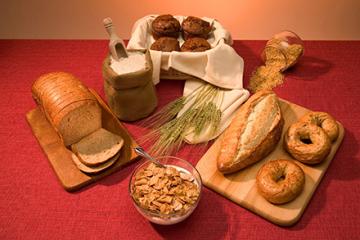Enlisting Fiber in the Fight Against AMR

Bran muffins, brown rice, whole-wheat loaf bread, whole-wheat bagels, whole-grain cereal, whole-wheat sliced bread, and whole-wheat flour contain 2.5 grams or more of fiber. (Stephen Ausmus, D001-1)
ARS researchers found that a high fiber diet is associated with lower antimicrobial resistance.
Ongoing research is showing that a diet high in fiber has many health benefits. Diets high in fiber have been shown to correlate with improved immune system regulations and a decrease in colorectal cancer. ARS scientists also found that healthy diets that are diverse and high in fiber can result in lower antimicrobial resistance.
While conducting dairy science research, Danielle Lemay, a research scientist for the Western Human Nutrition Research Center in Davis, CA noticed that cows’ antimicrobial resistance genes decreased when they had a high fiber intake in their diet. From this research, Lemay hypothesized whether the same relationship might exist in humans. Together with Andrew Oliver, a postdoctoral fellow in her lab, she began to look at microbes and antimicrobial resistance.
“Microbes have thousands of genes, so they’re able to consume all kinds of things that we wouldn’t be able to digest without them,” Lemay said. “Microbes can share genes and it is important to keep the number of anti-microbial resistance genes lower.”
Antimicrobial resistance can be detrimental to our health by making infections difficult or even impossible to treat.
“Microbes can trade genes, including ones that make them resistant to antibiotics,” Lemay said. “This is a problem because let’s say you’re developing an infection and you need to be given antibiotics to kill the infection, but if the bug already has this antibiotic resistance gene, then the antibiotic will not work.”
Lemay leveraged an observational trial of 290 people ages 18-65. “Because the study is observational, a follow-up study where people are fed a specific diet is needed,” Lemay said.
“With this research, we found that having a more diverse diet that is high in fiber is associated with lower anti-microbial resistance,” Lemay said.
Aminoglycosides and tetracycline are classes of antibiotics that are used to treat certain types of bacterial infections. According to the study by Lemay and Oliver, they found genes that gave microbes resistance to these antibiotics.
“We found that a gene that helps confer aminoglycoside resistance was negatively correlated with fiber intake,” Oliver said.
The researchers acknowledge that the observational nature of their study makes it difficult to say with certainty why certain antibiotic resistance genes seemed associated with diet while other genes did not.
The next step is to conduct an interventional trial, in which Lemay will provide specific diets to people to measure how that effects the abundances of anti-microbial resistant genes.
Lemay believes that this research is critically important for all of us.
“At some point in your life, you’re probably going to be infected with some pathogen for which you need antibiotics to work,” Lemay said. “The number one reason you should incorporate fiber in your diet is to create a healthy gut. This can also protect others around you.”
“We hope that studies like ours might not only spark new research directions, but also start conversations surrounding dietary recommendations,” Oliver said. “This will serve as a potential tool to help curb anti-microbial resistance.” — By Fiona Hernandez, ARS’s Office of Communications

